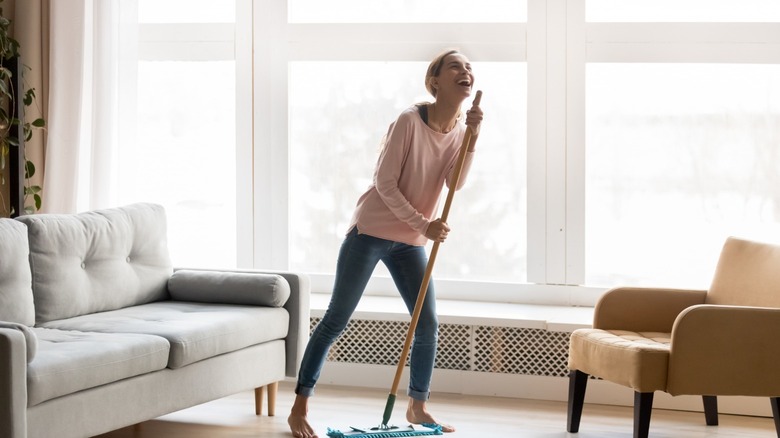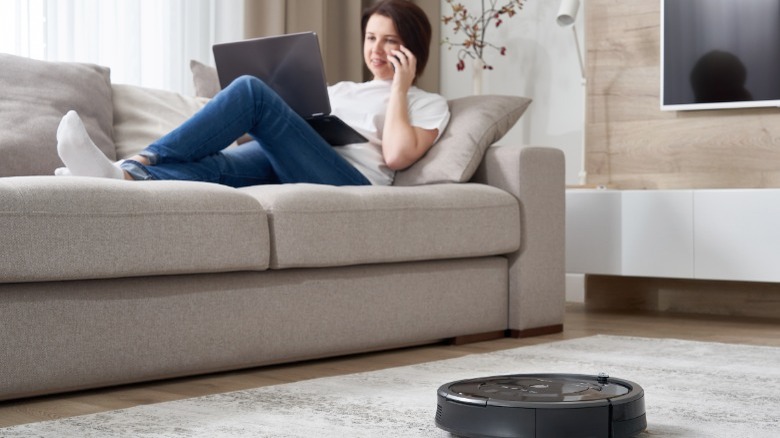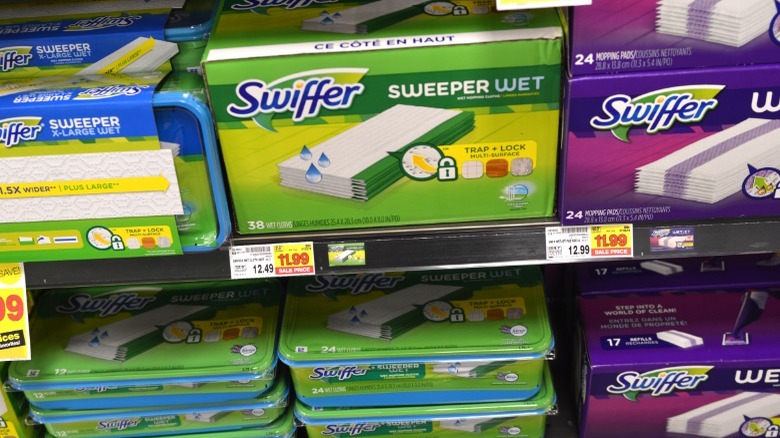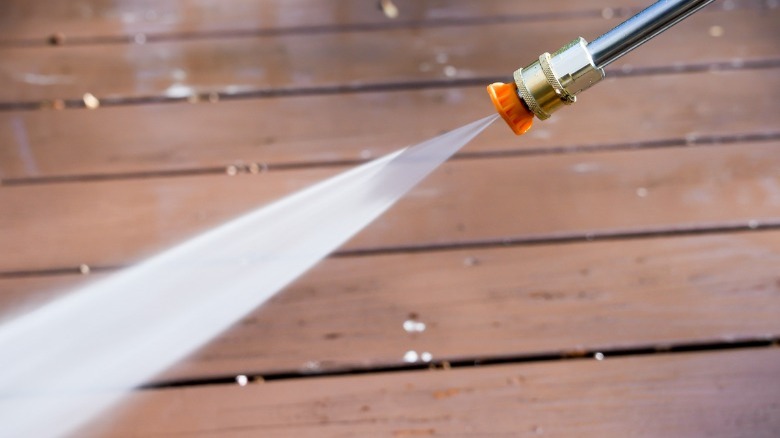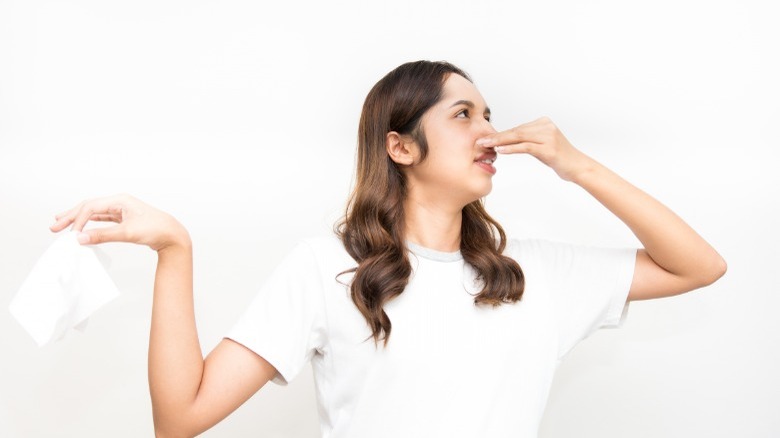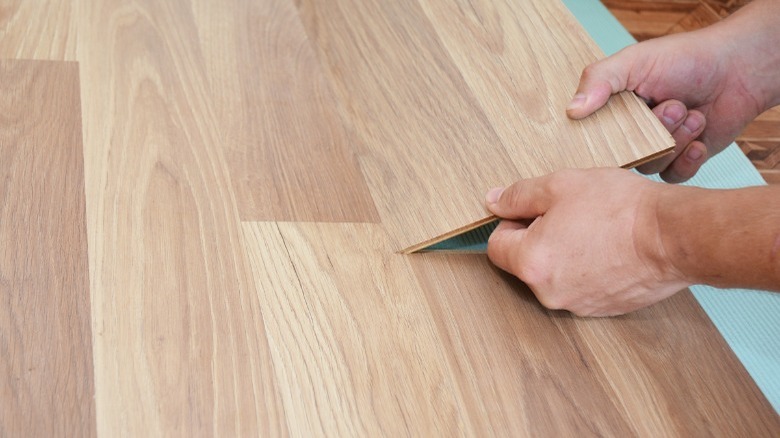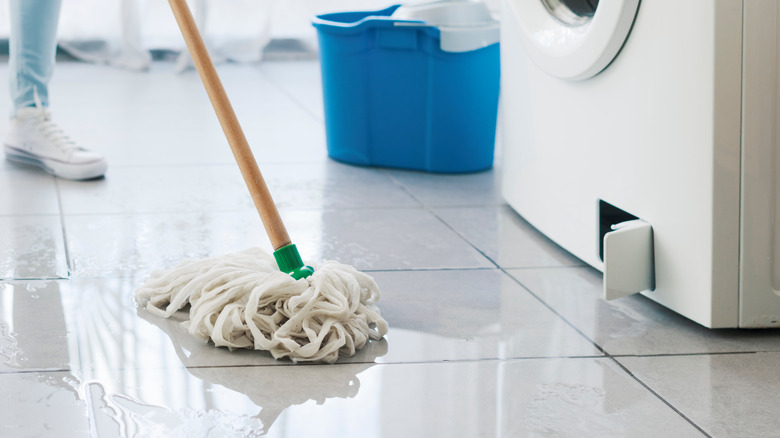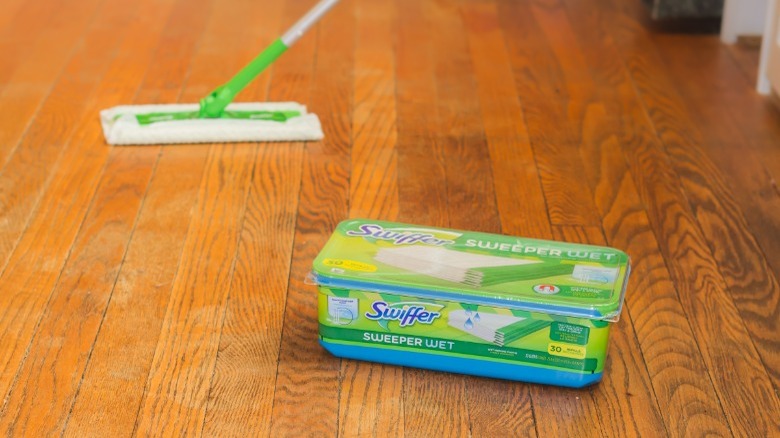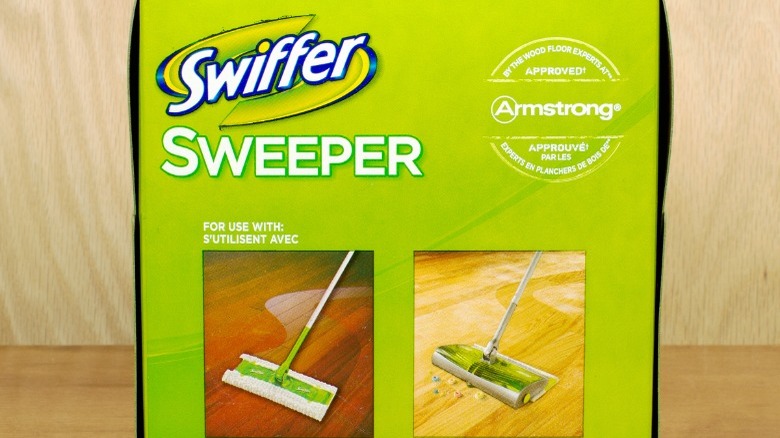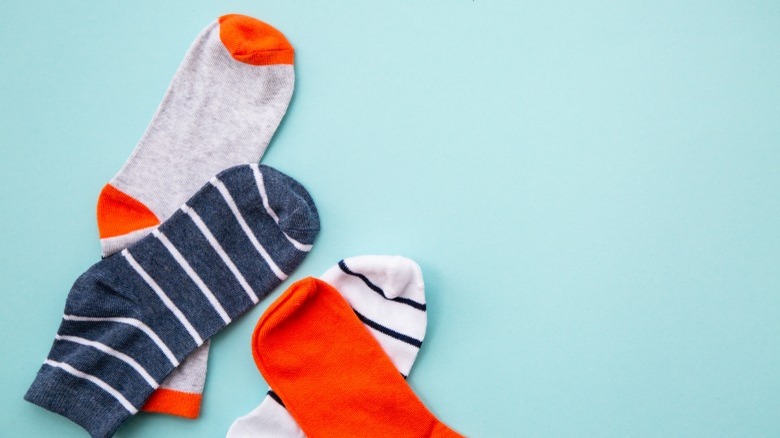Mistakes That You're Making With A Swiffer
We may receive a commission on purchases made from links.
If you're like millions of Americans today you probably own a Swiffer. They're incredibly convenient and most of us use them in all kinds of ways around the house. Swiffers are versatile and perfect for hard-to-reach places. They help us keep our homes free from dust, pollen, pet hair and dander, and other bacteria and allergens. It's the perfect cleaning assistant for cleaning stairways, getting under your couch, and cleaning along baseboards, just to name a few.
But, there are some common mistakes people make with Swiffers. From using them on surfaces they shouldn't be used on, to not getting the most out of a Swiffer pad, there are plenty of hacks to make sure you're using these cleaning tools correctly. Let's learn about mistakes we're making when using Swiffers, and what to do instead.
Using a Swiffer without vacuuming first
One common mistake people make is not optimizing their Swiffer's lifespan by vacuuming first. Generally, when using your Swiffer on your floors, be sure to vacuum up any excess debris and dust bunnies beforehand. Then use the dry pads on the Swiffer to dust the floor. After that, use the wet pads to mop the floors. Doing this will extend the life of the pads you use and even the Swiffer itself. It's important to keep in mind that the Swiffer is made for light-duty cleaning and will last much longer and perform better when used accordingly.
This applies especially when using a Swiffer WetJet or with wet pads on a 2-in-1 Swiffer. If you're dusting other areas of your house with a Swiffer Sweeper as many of us do, you'll want to vacuum afterward. But to optimize the performance of your Swiffer when cleaning the floors with it, vacuum or sweep them first.
Cleaning marble floors and surfaces with it
Although the Swiffer was designed to use on most floor types, there are still a few surfaces you should steer clear of. One of those is marble flooring. Apparently, a chemical in the Swiffer cleaning agent reacts with marble surfaces and can quickly result in expensive or irreparable damage. The marble tiles or marble surfaces will become eroded and the cleaner can leave permanent marks on tile and other marble surfaces.
Additionally, unfinished or unsealed tiles should not be cleaned with a Swiffer. Unprotected tiles such as these are fragile and can become etched or otherwise damaged beyond repair. Therefore, be sure to leave your beloved Swiffer in the closet when cleaning all types of marble surfaces. This includes the Swiffer Wet-Jet, which has a pH balance of 10, making it alkaline. Marble requires a neutral pH-balanced product between six and eight. Weiman Stone & Tile Cleaner is alternatively recommended, which you can find at Home Depot for $8.97.
Using generic pads
A common mistake many people make when it comes to their Swiffer is trying to save money by buying generic pads for it. This is not to say that the generic versions of products are always incomparable because we've all found acceptable imitations now and then. However, in the Swiffer pads department, you definitely get what you pay for. Don't make the mistake of thinking you're going to be saving money by trying out an off-brand, because it's going to end up costing you money instead.
Some generic products are made nearly exactly the same as the product that inspires them. However in the case of the Swiffer, all the important core aspects of what makes it a Swiffer have been patented. Therefore, there can be attempts to mimic Swiffer pads, but they're a far cry from the real thing. You can typically see with your own eyes the difference in quality and thickness by putting them side by side. The lesson here is you'll end up spending more money on generic pads because you'll have to buy more of them to get the job done.
Cleaning wooden decks with it
Since wooden decks are typically not finished in the same manner that hardwood floors inside the house are, a Swiffer is probably not the best cleaning tool for the deck. It's mostly the roughness of the wood itself that makes it not an ideal candidate for a Swiffer. After all, the Swiffer is made for gliding over smooth surfaces and grabbing dirt and grime with the patented grooved cloths. When you try to Swiffer across unfinished wood, you're going to snag it. It's really as elementary as that!
Normally Swiffers are highly recommended for finished wood surfaces. They're well-suited for cleaning hardwood floors and are great for most smooth surfaces in general. Since the surface and grain of the wood on decks are rougher than that found indoors, you shouldn't choose your Swiffer for cleaning them. Instead, you can just use a regular mop for cleaning wooden decks to avoid any snags or Swiffer slivers.
Throwing away used pads prematurely
One common mistake people make is throwing away Swiffer pads too soon. Something many people don't realize is that the way dry Swiffer pads work is by picking up dirt through an electrostatic charge. This gives them great lasting power because you can simply wipe off a lot of the dirt and hair you pick up and continue to use them for much longer than expected. Additionally, looks can be deceiving! Even when your Swiffer pads look like they're full of dirt and all used up, keep using them until they actually stop working.
This is one of the select secrets of seasoned Swifferers. By using these tricks to maximize the usage of each pad, you'll be surprised how much longer they last. Even if you use your Swiffer every day for light maintenance cleaning, you can typically use a pad for an entire week before needing to replace it with a new one.
Cleaning oiled, waxed, or unfinished wood floors with it
Although it's now well established that a Swiffer is terrific at maintaining floors, there are a few types that are specifically not recommended for Swiffering. Hardwood floors are probably one of the most common types of Swiffer-friendly surfaces. However, there are a few exceptions to the rule. If your floors are unfinished or if they have an oil or wax finish on them, a Swiffer is not recommended for cleaning them. You can use the dry pads of course, but not the wet pads or the Swiffer WetJet. This is due to the fact that unfinished or waxed floors may be sensitive to water-based products.
If you still want to give it a shot, test a portion of the floor that is out of sight. Use a corner of one of the wet pads for wood floors and wipe a spot in the corner. Use your hand to rub vigorously in that spot and then let it dry. If you don't notice any obvious fading or discoloration, you're probably safe. As a rule, however, don't use your Swiffer on those surfaces.
Trying to use your Swiffer for major deep cleaning projects
The Swiffer 2-in-1 is made to be one of the most versatile and competent cleaning tools in your closet. In fact, any Swiffer product easily falls into the category of being one of the few basic essentials for home care. Many of us use them daily and can scarcely imagine life without our trusty Swiffers. That said, they're not the best cleaning tool to get out when you're preparing for spring cleaning or other major deep cleaning projects. You might have to break out the heavier equipment for these jobs.
But don't despair! By using your Swiffer in daily maintenance tasks around the house, it will make those dreaded cleaning overhauls much less daunting. When you do have to break out the big guns, you'll be amazed at how much easier those projects are.
Not reusing pads in a pinch
Something you might not know is that most used Swiffer pads can be hand washed in the sink with hot water and soap and reused in a pinch. In fact, some people put them in the washing machine inside a mesh bag to clean them. There are many different versions of how to clean them best, but the bottom line is the fact that it's possible to wash and reuse them. This is huge, and great news for those of us who are trying to save money any way we can!
According to The Cool Down, an Instagrammer named @thelowwastegal posted a hack that turns Swiffer pads into reusable ones with a cleaning method of her own. You can use an empty liquid laundry detergent bottle or a container with a lid and a wide mouth that can hold at least 6 cups of liquid and several Swiffer pads. Mix four cups of distilled water and two cups of white vinegar with 10-14 drops of lemon essential oil as a degreaser. Soak dirty Swiffer pads in the solution for an hour or up to overnight and then rinse clean and air or sun dry. Who knew?
Using only one side of your Swiffer pads
If you have only been using one side of your Swiffer Sweeper pads, look at the flip side! You might have wondered about whether or not you could use the other side of the dry pads or not. If you ever inspected the other side of the pad, you may have noticed it's smooth in comparison to the patented grooved side. While one could assume that means you can't use that side, you would be wrong. In fact, you can flip the pad over and use the smooth side to dust along baseboards, door frames, staircase railings and banisters, and more.
The "wrong" side of the Swiffer pad is good for getting in corners, too. This knowledge opens up a whole new world of possibilities! Plus, being able to use the flip side of your Swiffer pads will help you get the maximum use out of each and every pad. Combine this with washing and reusing the pads and you will be amazed at how much less often you'll need to buy them.
Not using your Swiffer even when you run out of pads
Ok, so we've pretty much established how essential our Swiffers are in day-to-day life, and covered some common mistakes to avoid and help you make the most of yours. All the Swiffer cleaning tools are wonderful products, and we've got one more valuable tip for you before we go. If you've ever started on your household chores and went to grab your Swiffer from the closet, only to find you're out of pads – don't panic! You might be surprised to know that there are other options if you're really in a bind.
When you're all set to begin and realize you're out of pads, it's time to raid that pile of single socks that lost their mates in the dryer vortex. A nice fuzzy sock works best. Alternatively, you can use a microfiber cloth or even a wash rag or a heavy-duty paper towel. So don't make the mistake of thinking all is lost if you're out of pads for your Swiffer. Use it with what you've got!
